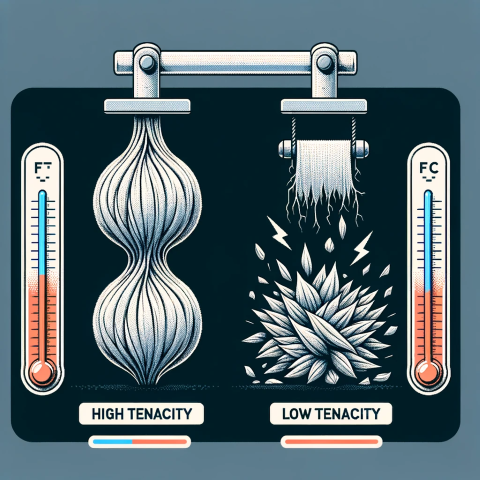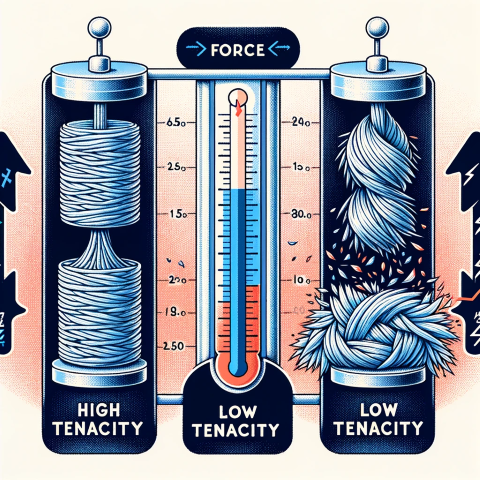Last Updated on: 10-Feb-2024 (5 months, 17 days ago)
Share on Facebook • Share on Twitter
Tenacity Defined: How Fiber Strength Determines Fabric Durability
The tenacity of a fiber is determined by its molecular structure and the way that its molecules are arranged. Fibers that have a high degree of crystallinity and are tightly packed together tend to be more tenacious than fibers that have a less ordered structure. The length and diameter of a fiber also affect its tenacity, as longer and thicker fibers tend to be stronger than shorter and thinner fibers.
In textiles, tenacity is an important property to consider when selecting fibers for specific applications. Fibers that are used in applications where they will be subjected to a lot of stress or tension, such as in ropes or seat belts, need to be very tenacious to ensure that they do not break under load.
The tenacity of a fiber is typically measured in grams per denier (g/d). Denier is a unit of measurement that is used to describe the thickness of fibers, and it is equal to the weight in grams of 9,000 meters of the fiber. So, a fiber with a tenacity of 5 g/d means that it can withstand a load of 5 grams per 9,000 meters of the fiber.
Different fibers have different levels of tenacity. For example, nylon is a synthetic fiber that is known for its high tenacity, with some types of nylon having a tenacity of over 10 g/d. Polyester is another synthetic fiber that is known for its strength, with some types of polyester having a tenacity of up to 9 g/d. Natural fibers such as cotton and wool tend to have lower tenacity values, with cotton typically having a tenacity of around 3-4 g/d and wool having a tenacity of around 1-2 g/d.
In addition to its use in determining the strength of fibers, tenacity is also an important property to consider when evaluating the performance of textiles. Textiles that are made from high-tenacity fibers tend to be more durable and long-lasting, as they are less likely to break or tear under stress. This makes high-tenacity fibers ideal for use in applications such as outdoor gear, where durability and resistance to wear and tear are important.
In conclusion, tenacity is an important property of fibers that measures their strength and ability to resist breaking or stretching when subjected to tension or stress. It is typically measured in grams per denier and is determined by the molecular structure and arrangement of the fiber. Different fibers have different levels of tenacity, with synthetic fibers such as nylon and polyester typically having higher values than natural fibers such as cotton and wool. Tenacity is an important consideration when selecting fibers for specific applications, and textiles that are made from high-tenacity fibers tend to be more durable and long-lasting.
�The property of fibers that measures strength. This is determined by the force required to rupture of break the fiber. Typically, this is measure is grams per denier, or g/d. Tensile strength measres textile strength, measured in pounds per square inch to break a fabric.
Some more terms:
Cyanoacrylate
Cyanoacrylate is a type of adhesive that is commonly used in textiles. It is a fast-acting adhesive that forms a strong bond between two surfaces, making it ideal for use in the textile industry. The...
Read about CyanoacrylateCatalyst
In the context of textiles, a catalyst refers to a substance or agent that speeds up or facilitates a chemical reaction without being consumed or permanently altered in the process. Catalysts play a...
Read about CatalystSweaters: From Fishermen's Armor to Fashion Frontlines
A sweater, pullover, jumper or jersey is a relatively heavy garment intended to cover the torso and arms of the human body (though in some cases sweaters are made for dogs and occasionally other...
Read about SweaterDead Cotton
1. FIBRE. General term used for immature, undeveloped cotton fibres. May cause increased nep-piness on the fabric and also may cause uneven dyeing. May show up as undyed specks, due to poor dye...
Read about Dead CottonToner
Toner, in the context of textiles, refers to a type of colorant or dye used to impart color to fabrics or fibers. It is a finely powdered substance composed of pigments, binders, and other additives,...
Read about TonerBroken Filaments
Rupture of individual filaments (usually during winding or weaving) that results in the appearance of a fibrous or hairy surface, which may be localised or general, in a fabric made from flat...
Read about Broken FilamentsCollar Chronicles: Unveiling the Neckline Evolution
The Collar in Textile: A Comprehensive GuideIn the realm of textile, the collar is a significant component that adds style, structure, and character to garments. This comprehensive guide dives into...
Read about CollarSpandex
A manufactured elastomeric fiber that can be repeatedly stretched over 500% without breaking, and will still recover to its original length. Spandex increases the life of a garment, making it more...
Read about SpandexAdd a definition
- The term you want to define
- Its definition in 500 words or less
- Attach an image if necessary.
- Optionally, tell us about yourself in 200 words or less!
Companies for Tenacity:
- Company name
- Company address
- Attach a logo, if necessary.
- Optionally, tell us about yourself in 200 words or less!

 Fashion designer Betsey Johnson survived breast cancer and has been a strong advocate for awareness.
Fashion designer Betsey Johnson survived breast cancer and has been a strong advocate for awareness.

